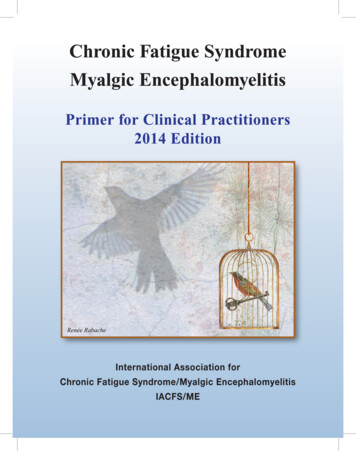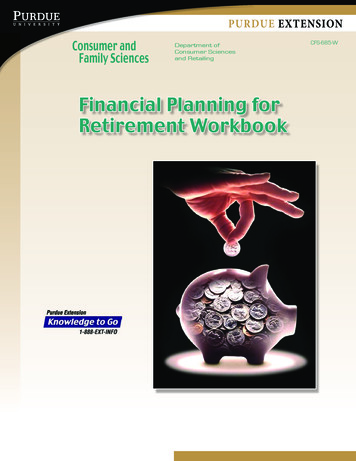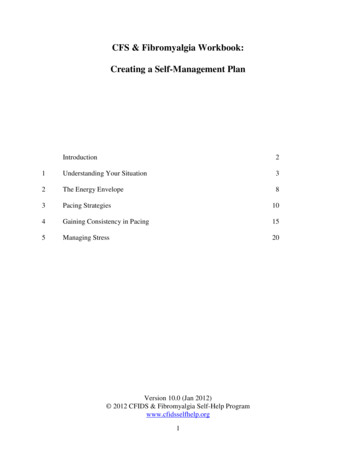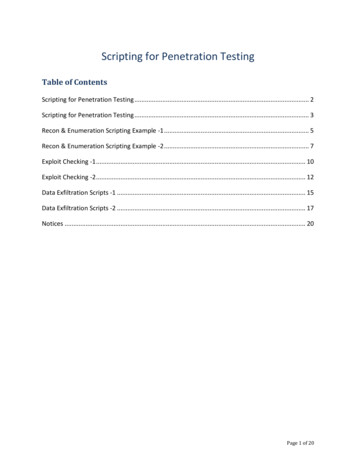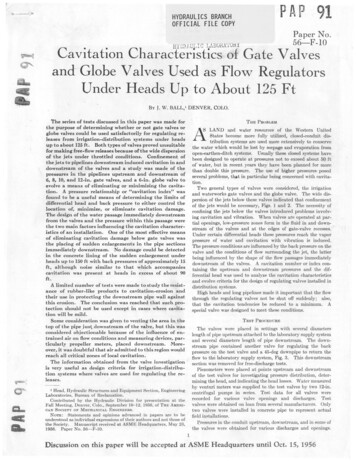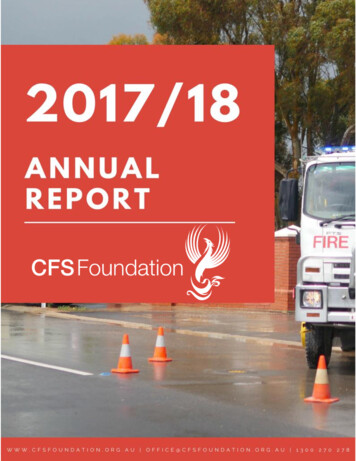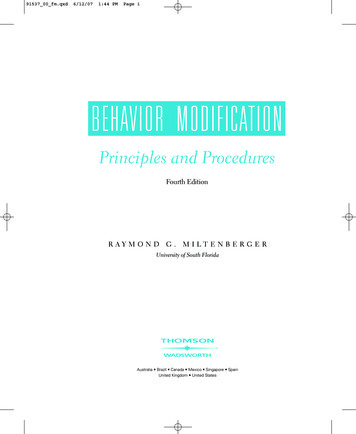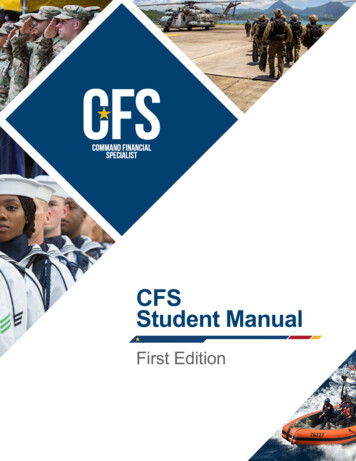
Transcription
CFSStudent ManualFirst Edition
Table of Contents – Student ManualCFS Chapters 1 – 15CFS 1 Welcome, Introduction and AdministrationCFS 2 The Need for PFMCFS 3 Introduction to CFSCFS 4 Introduction to Managing FinancesCFS 5 Financial CounselingCFS 6 Financial Counseling ApplicationCFS 7 Introduction to Financial Planning WorksheetCFS 8 Morgan Wayne Case StudiesCFS 9 Personal Financial RecordkeepingCFS 10 Legal Issues of PFMCFS 11 Your Credit and Your ClearanceCFS 12 Financial Referral ResourcesCFS 13 Instructional TechniquesCFS 14 Survivor Benefit PlanCFS 15 Developing Your Program
CFS 1Welcome,Introduction andAdministrationStudent Manual
CFS 1SMI. INTRODUCTIONWelcome to the Command Financial Specialist Training Course! In this first training chapter, we will haveparticipant introductions; review course administration, the purpose of the training and the course agenda;and complete the course pretest. As we proceed through today’s topics, you will become familiar with theCommand Financial Specialist Program and understand more fully why you are here and why yourcommand has chosen you to be one of its representatives.Chapter Correlation to Common CFS Task Areas:1. Education and Training: Introduces you to major topic areas viaagenda review. Training techniques include active participation,chapter review, lecture, and student introductions.2. Information and Referral: Introduces you to major topicareas via agenda review and the pretest. Introduces studentsto each other as possible referral resources.3. Counseling/Coaching: Introduces you to major topic areas viaagenda review. Counseling/coaching technique practice begins ndReferralTASKCounseling/CoachingII. LEARNING OBJECTIVESN/A (this is an administrative chapter)III. REFERENCESNavy OPNAVINST 1740.5DMarine Corps MCO 1700.37Army DoDI 1342.22-DCoast Guard COMDTINST 1740.8 (series)Kirkpatrick, D.L. (2007). Implementing the Four Levels: A Practical Guide for Effective Evaluation ofTraining Programs. San Francisco: Berrett-Koehler Publishers Inc.McCain, D.V. (2005). Evaluation Basics. Alexandria, VA: ASTD PressWelcome, Introduction and Administration1-1
IV. CONTENTCourse Terminal ObjectivesUpon completion of this course, learners should be able to: Construct, organize and/or manage a comprehensive, proactive PFM program at the commandlevel (which may be measured by quarterly reporting requirements). Conduct effective PFM education and training using the PFM Standardized Curriculum andTouchpoint Training materials. Provide appropriate information and referral resources for clients evidenced by participation in classrole-play and case studies. Conduct effective one-on-one counseling/coaching for clients using Solution-Focused FinancialCounseling tools and techniques.Financial Training TopicsThe course will provide training designed to teach you how to be a CFS and training designed toteach you how to use the Touchpoint Training materials.Specific topics covered during the Command Financial Specialist Training are:Core Curriculum:CFS 1 Welcome, Introduction and AdministrationCFS 2 The Need for PFMCFS 3 Introduction to CFSCFS 4 Introduction to Managing FinancesCFS 5 Introduction to Financial CounselingCFS 6 Financial Counseling Application (Jordan Dough)CFS 7 Introduction to the Financial Planning Worksheet (FPW)CFS 8 Morgan Wayne Case StudiesCFS 9 Personal Financial RecordkeepingCFS 10 Legal Issues of PFMCFS 11 Your Credit and Your ClearanceCFS 12 Financial Referral ResourcesCFS 13 Instructional TechniquesCFS 14 Survivor Benefit PlanCFS 15 Developing Your ProgramTouchpoint Curriculum:TC 1 Introduction to Touchpoint CurriculumTC 2 First Duty StationTC 3 Permanent Change of Station (PCS)TC 4 PromotionTC 5 Vesting in the TSPTC 6 Entitlement to Continuation Pay (CP)TC 7 MarriageTC 8 Welcoming Your First ChildTC 9 Preparing for DivorceTC 10 Disabling Sickness or ConditionTC 11 Leadership TrainingTC 12A Pre-DeploymentTC 12B Post-DeploymentFinancial topics not covered in the CFS Course are:Banking and Financial ServicesCar BuyingConsumer AwarenessCredit ManagementGambling AwarenessHome Buying/RentingHow to Survive the Holidays FinanciallyMilitary Pay IssuesPaying for CollegePaying off Your Student LoansPlanning for Your RetirementRaising Financially Fit KidsRentingSaving and InvestingSmart Transition PlanningYour Insurance NeedsVacation PlanningFirst Duty StationPost-DeploymentThrift Savings PlanWelcome, Introduction and Administration1-2
Meet Your ClassmatesPair up with another class member and interview them for answers to the following questions:1. Name:2. Command:3. Job or position at command:4. What do you hope to learn in CFS training?5. How will you use what you learn during the course?6. What non-military financial experience do you bring to the classroom?Welcome, Introduction and Administration1-3
CFS Course MaterialsStudent ManualYour manual is separated into two sections. The first section includes the CFS chapters that provideinformation on how to be a CFS. These chapters are numbered as CFS 1, CFS 2, etc. The order followscourse topics except CFS 6 which is presented later in the course, but conveniently located in this StudentManual next to CFS 5 for ease of use during the counseling role-play. The second section includes theTouchpoint chapters that introduce learners to the Touchpoint Training materials. These chapters arenumbered as TC 1, TC 2, etc. The order follows the roadmap to financial success (as discussed later in thecourse). This Student Manual is your workbook for the class, and it is yours to keep. We will be actively usingthe pages in this workbook to complete both in-class activities and after-class homework. Please makenotes as we proceed through the information on each topic so that you can refer to them later as needed.Each CFS chapter will be structured as follows:I.IntroductionII.Learning ObjectivesIII.ReferencesVI.ContentEach TC chapter will be organized as follows:I.IntroductionII.Learning ObjectivesIII.ReferencesIV.Acronyms and AbbreviationsV.Touchpoint ToolboxVI.Additional Learning and ActivitiesThe Student Manual has been developed as a standardized workbook and companion to the CFS trainingclass. Some of the material is generic in nature. You should use this workbook to make notes on yourmilitary branch, local information, and any updated information provided to you during the course.To facilitate the use of these instructional materials, the following terms and acronyms will be used:Command Financial Specialist Training . CFSTCommand Financial Specialist .CFSCommand Financial Specialist Instructor Guide. IGCommand Financial Specialist Training Instructor . InstructorCommand Financial Specialist Training Participants.LearnersCommand Financial Specialist Training Student Manual . SMFinancial Planning Worksheet .FPWPersonal Financial Management Standardized Curriculum . PFMSCPersonal Financial Management . PFMTouchpoint Curriculum . TCWelcome, Introduction and Administration1-4
Common CFS Task AreasThe Personal Financial Management program has three common CFS task areas across military branches:education and training, information and referral, and counseling/coaching. These are woven throughout thecourse:Chapter Correlation to Common CFS Task Areas:1. Education and Training: This topic is covered both through modeling and direct training on the topic.PFM Touchpoint Curriculum modules are used directly throughout the course and both the PFMStandard Curriculum (PFMSC) and Touchpoint Training material will be provided to you to use bothas a resource for content and for program development. Although training techniques and TouchpointTraining materials are modeled, the PFMSC modules are not modeled. However, you are provided withall the training materials you need to conduct successful PFM education and training in accordancewith your branch of service’s policy. Instructional techniques will be reviewed to reinforce further thetechniques that have been modeled.2. Information and Referral: This topic is woven throughout the course and most topics will includesources of help. Guest speakers are invited from common referral resources such as the Navy-MarineCorps Relief Society (NMCRS), Army Emergency Relief (AER), Coast Guard Mutual Assistance (CGMA),Fleet and Family Support Center (FFSC), Marine-Corps Community Services (MCCS) Marine & FamilyPrograms, Army Community Service (ACS), and Coast Guard Office of Work-Life. The topic issupplemented with dedicated resource training where students are given mini-case studies. Otherresources presented during the course can include speakers from the local disbursing or admin office,Legal Services Office, nonprofit debt-management counseling agencies, exchange, credit-reportingagencies, TRICARE, base housing, the Exceptional Family Member or Special Needs program, andexperienced Command Financial Specialists. You will have been exposed to a wide variety of referralresources either in person or through case study by the end of the course.3. Counseling/Coaching: You will be exposed to counseling/coachingtools and techniques throughout the course and during counselingrole-plays. Solution-Focused Financial Counseling and an 8-Stepcounseling cycle are introduced early in the training, and specificskills in Solution-Focused Financial Counseling are practiced vialecture and role-plays.The introduction for each CFS chapter includes a “ChapterCorrelation to Common CFS Task Areas” section. To locate thissection, look for this symbol at the beginning of each chapter(see the CFS 1 Welcome, Introduction and Administrationexample on page KCounseling/CoachingWelcome, Introduction and Administration1-5
DVDs or DoD WebsiteAll of the Personal Financial Management Standardized Curriculum (PFMSC) materials and TouchpointTraining materials will be provided to you for your future use. You will also be provided a variety of materialsto assist you in your job as a CFS. These items are yours to keep at your command. They will provide youwith additional reference information and training materials, as well as forms used for the CFS Program.In addition to these materials being available on your PFMSC DVD, you can also find them on the DoDwebsite or via your Installation Family Support Center’s CFS Instructor.Learner-Centered ActivitiesCommand Financial Specialist Training is conducted using many different training techniques. As adult learners,you are expected to participate in all aspects of the training. You are encouraged to speak openly and torespect each other’s opinions. Your full participation in all class activities, including practical applications tobe done after class, is vital to the success of this training.Dot-com DisclaimerDuring the course, you will hear references to a variety of websites. These sites are for educational purposesonly. No warranty is made regarding their accuracy or quality, nor does using the information on these sitesconstitute an endorsement of the site, its products or its services. Other sites with similar information maybe available and may prove equally useful.Welcome, Introduction and Administration1-6
CFS Course EvaluationCFS Training — Monday: “Personal Financial Management”(Dates: )StronglyAgreeAgreeSomewhatStronglyAgree Disagree DisagreeWelcome, Introduction and Admin (CFS 1)Instructor was knowledgeable – Instructor NameContent was clear and understandableThe Need for Personal Financial Management (CFS 2)Instructor was knowledgeableContent was clear and understandableIntroduction to Command Financial Specialist (CFS 3)Instructor was knowledgeableContent was clear and understandableIntroduction to Managing Finances (CFS 4)Instructor was knowledgeableContent was clear and understandableFinancial Counseling (CFS 5)Instructor was knowledgeableContent was clear and understandableIntroduction to the Financial Planning Worksheet (CFS 7)Instructor was knowledgeableContent was clear and understandableeFPW Walk-Through of Morgan Wayne Case Study One (CFS 8)Instructor was knowledgeableContent was clear and understandableWhat was most impactful from today’s modules?Please list any suggestions on how best to improve the content or organization of the material presented:Thank you for your feedback so we can provide the best course possible.Welcome, Introduction and Administration1-7
CFS Course EvaluationCFS Training — Tuesday: “Referral Resources”(Dates: )StronglyAgreePersonal Financial Recordkeeping (CFS 9)Instructor was knowledgeable – Instructor NameContent was clear and understandableAgreeSomewhatStronglyAgree Disagree DisagreeLegal Issues of Personal Financial Management (CFS 10)Instructor was knowledgeableContent was clear and understandableYour Credit and Your Clearance (CFS 11)Instructor was knowledgeableContent was clear and understandableFinancial Referral Resources with Case Studies (CFS 12)Instructor was knowledgeableContent was clear and understandableReferral Resources Guest SpeakersInstructor was knowledgeableContent was clear and understandableInstructor was knowledgeableContent was clear and understandableInstructor was knowledgeableContent was clear and understandableInstructor was knowledgeableContent was clear and understandableInstructor was knowledgeableContent was clear and understandableInstructional Techniques (CFS 13)Instructor was knowledgeableContent was clear and understandableMorgan Wayne Case Study Two (CFS 8)Instructor was knowledgeableContent was clear and understandableWhat was most impactful from today’s modules?Please list any suggestions on how best to improve the content or organization of the material presented:Thank you for your feedback so we can provide the best course possible.Welcome, Introduction and Administration1-8
CFS Course EvaluationCFS Training — Wednesday: “Touchpoint Day 1”(Dates: )StronglyAgreeAgreeSomewhatStronglyAgree Disagree DisagreeTouchpoint Tools (TC 1)Instructor was knowledgeable – Instructor NameContent was clear and understandablePresentation 1: Vesting in the TSP (TC 5)Instructor was knowledgeableContent was clear and understandablePresentation 2: Entitlement to Continuation Pay (TC 6)Instructor was knowledgeableContent was clear and understandablePresentation 3: Permanent Change of Station (TC 3)Instructor was knowledgeableContent was clear and understandablePresentation 4: Promotion (TC 4)Instructor was knowledgeableContent was clear and understandableMorgan Wayne Case Study Three (CFS 8)Instructor was knowledgeableContent was clear and understandableWhat was most impactful from today’s modules?Please list any suggestions on how best to improve the content or organization of the material presented:Thank you for your feedback so we can provide the best course possible.Welcome, Introduction and Administration1-9
CFS Course EvaluationCFS Training — Thursday: “Touchpoint Day 2”(Dates: )StronglyAgreeAgreeSomewhatStronglyAgree Disagree DisagreeMorgan Wayne Case Study Four (CFS 8)Instructor was knowledgeable – Instructor NameContent was clear and understandablePresentation 5: Leadership Training (TC 11)Instructor was knowledgeableContent was clear and understandablePresentation 6: Pre-Deployment (TC 12A)Instructor was knowledgeableContent was clear and understandablePresentation 7: Major Life Event (TC 7-10)Instructor was knowledgeableContent was clear and understandablePresentation 8: Major Life Event (TC 7-10)Instructor was knowledgeableContent was clear and understandableFinancial Counseling Application (CFS 6)Instructor was knowledgeableContent was clear and understandableWhat was most impactful from today’s modules?Please list any suggestions on how best to improve the content or organization of the material presented:Thank you for your feedback so we can provide the best course possible.Welcome, Introduction and Administration1-10
CFS Course EvaluationCFS Training — Friday: “Program Development”(Dates: )StronglyAgreeAgreeSomewhatStronglyAgree Disagree DisagreeSurvivor Benefit Plan (CFS 14)Instructor was knowledgeable – Instructor NameContent was clear and understandableDeveloping Your Program (CFS 15)Instructor was knowledgeableContent was clear and understandableExcellent Very GoodGoodFairPoorEffectiveness of this course in preparing me to be a CFSMy level of knowledge before this courseMy level of knowledge after this courseWhat was most impactful from today’s modules?What are 1-3 things about the CFS course that could be improved to better support learning?Please indicate if/how your outlook toward personal finance has changed because of this course:What parts of this course have best prepared you for providing CFS duties at your command?(consider both pre-work and course work)Thank you for your feedback so we can provide the best course possible.Welcome, Introduction and Administration1-11
Daily HomeworkPre-Work (completed prior to the course)a.b.Completely read your Service-Specific PFM Program Policy (in Appendix A).Completely read your Service-Specific Indebtedness Policy (in Appendix B).Day Onea.b.c.d.e.Complete How Do You Rate as a Money Manager? and the Financial Values Clarification sheets onpages 5-12 and 5-13 of the Student Manual.Print your personal credit report and bring it to class on Tuesday morning.Answer questions in CFS 13 Instructional Techniques and read chapter.Begin your Personal Financial Planning Worksheet, to be handed in Wednesday morning.If you have a laptop with Microsoft Excel available, please bring it to class the rest of the week.Day Twoa.FPW: Complete your Financial Planning Worksheet, to be handed in first thing in the morning.Day Threea.Read CFS 5 Financial Counseling and CFS 6 Financial Counseling Application (pay specialattention to Role-Play: Jordan Dough Student Manual Instructions on page 6-10 in preparationfor the counseling Role-Play).Day Foura.b.Complete the Plan of Action and Milestones on page 15-9 of your Student Manual.This should reflect your plans for functioning as a CFS when you return to your command.Reminder: Completed Course Evaluations are your ticket out of class at the end of training,so ensure you have completed evaluations for Day One through Four tonight(pages 1-7 through 1-10 of your Student Manual).Welcome, Introduction and Administration1-12
CFS Course AgendaMondayTuesdayWednesdayIntroduction to Personal Financial ManagementWelcome, Introduction and Administration with Pretest (CFS 1)The Need for Personal Financial Management (CFS 2)Introduction to Command Financial Specialist (CFS 3)Introduction to Managing Finances and What Are My Options? Exercise (CFS 4)Financial Counseling (CFS 5)Introduction to the Financial Planning Worksheet (CFS 7)eFPW Walk-Through of Morgan Wayne Case Study One (CFS 8)Daily Debrief and EvaluationReferral ResourcesPersonal Financial Recordkeeping (CFS 9)Legal Issues of Personal Financial Management (CFS 10)Your Credit and Your Clearance (CFS 11)Financial Referral Resources with Resource Case Studies and Guest Speakers (CFS 12)Instructional Techniques (CFS 13)Morgan Wayne Case Study Two (CFS 8)Daily Debrief and EvaluationTouchpoint Day 1Touchpoint Tools (TC 1)Presentation 1: Instructor Example of Vesting in the TSP (TC 5)Team AssignmentsTeam Work TimePresentation 2: Team A – Entitlement to Continuation Pay (TC 6)Presentation 3: Team B – Permanent Change of Station (TC 3)Presentation 4: Team C – Promotion (TC 4)Morgan Wayne Case Study Three (CFS 8)Daily Debrief and EvaluationThursdayFridayTouchpoint Day 2Morgan Wayne Case Study Four (CFS 8)Presentation 5: Team D – Leadership Training (TC 11)Presentation 6: Team E – Pre-Deployment (TC 12A)Presentations 7 and 8: Teams F & G – Major Life Events –Marriage (TC 7); Welcoming Your First Child (TC 8); Preparing for Divorce (TC 9);Disabling Sickness or Condition (TC 10)Financial Counseling Application (CFS 6)Daily Debrief and EvaluationProgram DevelopmentSurvivor Benefit Plan (CFS 14)Developing Your Program (CFS 15)Post-testCourse Debrief and EvaluationPresentation of CertificatesWelcome, Introduction and Administration1-13
Navy & Marine Corps CFS Student Data CardName:Rate/Rank:DoD#:Branch of Service:Command (do not abbreviate):Installation or Duty Station:Work email:Work Phone:Rotation Date (PRD):Present Position:Date Attended Training:Location:DATA REQUIRED BY THE PRIVACY ACT OF 1974AUTHORITY: 5 U.S.C. Sec 301, which allows the Secretary of the Navy to make regulations for theDepartment of the Navy. One of these regulations, SECNAVINST 1754.1B, establishes the Navy FamilyServices Center Program. 5 U.S.C. Sec 552a, safeguards individual privacy from the misuse of federalrecords.PRINCIPAL PURPOSE: To enable the Chief of Naval Education and Training to record and track graduatesof the Command Financial Specialist Training Course. DOD ID Number will be used to provide positiveidentification.ROUTINE USES: The information obtained will become part of the Corporate enterprise Training ActivityResource System (CeTARS) and may be disclosed to routine users of such system.Unauthorized users will not have access to this protected information.Signature:Date:This form is only required for Marines and Sailors attending the course to facilitate entry into their training records.It needs to be filled out completely and signed.Welcome, Introduction and Administration1-14
CFS 2The Need for PFMStudent Manual
CFS 2SMI. INTRODUCTIONThe goal of this training topic is to provide an introduction to the importance of all Americans managing theirfinances and an overview of typical financial problems and concerns experienced by Service members. Wewill discuss the “presenting” financial concerns that may bring Service members to see you, as well as thereal reasons, emotional fallout, and implications of various financial issues.Chapter Correlation to Common CFS Task Areas:1. Education and Training: Models lecture, class participation,and training techniques2. Information and Referral: No direct correlation3. Counseling/Coaching: Introduces learners to the types ofpresenting financial problems they will encounter whileworking with clients, the real reasons financial problems occur,and typical emotional fallout from financial TASKCounseling/CoachingII. LEARNING OBJECTIVESLearners will use a group activity to distinguish among and list at least four presenting problems,real reasons, emotional fallout, and implications of financial problems.III. REFERENCESInstitute, M.F. (1997). Scope and Impact of Personal Financial Management Difficulties of Service MembersP. Tiemeyer, C.W. (1999). Financial Management Problems Among Enlisted PersonnelPersonal Financial Management Standardized Curriculum. (2016). CNIC Family Readiness ProgramManager Phuong, R.B. (2002). Assessing the Personal Financial Problems of Junior Enlisted PersonnelSanta Monica: RAND Corporation(2003). Report on Personal and Family Financial Management Problems. RAND CorporationIV. CONTENTThe Need for PFM2-1
Financial Problems and Concerns“Presenting Financial Concerns” are the types of issues that will motivate a client to come and see youas the Command Financial Specialist.1.2.3.4.5.6.7.8.9.10.“Real Reasons” the client might be coming to see you. This is some of the meat of your job as a CFS —listening to the Presenting Financial Concerns while trying to discern the Real Reasons for the problems.1.2.3.4.5.6.7.8.The Need for PFM2-2
Financial Problems and Concerns“Emotional Fallout” a client may be experiencing. These are the personal issues that can be linkeddirectly to the client’s financial problems. Your job as a CFS is to recognize that there is emotional falloutand make a referral to the proper resource.1.2.3.4.5.“Implications” of financial problems. These are detrimental impacts of personal financial problems for theService member, the command, and the military.Civilian Implications1.2.3.4.5.6.Military Implications1.2.3.4.5.6.The Need for PFM2-3
Financial Risk Factors for Military Members Youth/immaturityEarly independenceEarlier family responsibilitiesUnemployed or underemployed spouseHaving children earlierDeploymentsFrequent movesSeparation from extended familyHigh cost of livingStability of employmentAvailability of easy creditNational savings rateNotesThe Need for PFM2-4
CFS 3Introductionto CFSStudent Manual
CFS 3SMI. INTRODUCTIONThe goal of this training topic is to provide an introduction to the military’s PFM Program and a review of yourbranch of service’s PFM Program Policy (which details your roles and responsibilities as a CFS). This topicwill begin the discussion of how you as the CFS can use your skills to help fellow Service members.Chapter Correlation to Common CFS Task Areas:1. Education and Training: Introduces tasks. Introduces you to specifictopic areas of training via review of the PFM Policy, models lecture,class participation, and training techniques.2. Information and Referral: Introduces SK3. Counseling/Coaching: Introduces tasks.Counseling/CoachingII. LEARNING OBJECTIVESUsing the PFM Program Policy from their branch of service, learners will locate the key areas directlyimpacting their role as a CFS.III. REFERENCESDoD Instruction (DoDI) 1342.22 policy, assigns responsibilities, and establishes procedures for theprovision of military family readiness servicesOPNAV 1740.5D. (n.d.). United States Navy Personal Financial Management (PFM)MCO 1700.37 United States Marine Corps Personal Financial Management Program (PFMP)Army Regulation 608–1 Army Community ServiceCOMDTINST 1740.8 (series) United States Coast Guard Financial Management Program (PFMP)IV. CONTENTIntroduction to CFS3-1
Policy Review FormDIRECTIONS: Use your Service-Specific PFM Program Policy in Appendix A to locate the answers to thequestions for your branch of service. Highlight the answers in the policy and list the location where youfound each answer below.NAVYWhat are the four major elements of the Navy’s PFM Program?What is the responsibility of the Wardroom and Chief Petty Officers’ Mess?What are the responsibilities of individual Sailors?What are the minimum requirements to be reviewed in an ISIC’s inspection?Introduction to CFS3-2
Policy Review FormMARINE CORPSWhich preventative and intervention services are included in the Marine Corps’ PFM Program?List two of the responsibilities of the Commanding Officers (CO), Officer(s)-in-Charge (OICs),Inspectors-Instructors (I&Is), and Detachment Commanders?What is the Extended Absence Financial Plan that a CFS assists Marines in developing?What are the responsibilities of the Inspector General of the Marine Corps?Introduction to CFS3-3
Policy Review FormCOAST GUARDWhat are the seven elements of the Coast Guard’s PFM Program?How often must the CFS provide updates to the HSWL Regional Practice (HSWL-RP) PFM?What are the responsibilities of individual Coast Guard Service members and civilians?How often should the CFS report to the CO/XO the CFS activity (referrals and training) conducted at theircommand/unit?Introduction to CFS3-4
CFS Roles and ResponsibilitiesTo support mission readiness, and in accordance with DoD INST 1342.27 (12 Nov 04), Personal FinancialManagement (PFM) policies across the services, mandate that each installation provide a PFM program.Components of PFM Program by Military BranchNAVYMARINECORPSARMYCOASTGUARDEducation and TrainingInformation and ReferralFinancial CounselingFinancial CoachingConsumer AdvocacyCFS ProgramOutreachCollaboration and CoordinatingCG SUPRT Financial Wellness ProgramThe PFM program emphasizes a proactive, military career life-cycle approach to personal financial responsibility.The Command Financial Specialist (CFS), as the officially designated command unit-level representative,is the core of the PFM program.Responsibilities of a CFS by Military BranchNAVYMARINECORPSARMYCOASTGUARDEducation and TrainingInformation and ReferralFinancial CounselingInitial Financial Coaching/CounselingBasic BudgetingConsumer AdvocacyNote: At the time of this publication, the U.S. Army does not have an Army Regulation for the CommandFinancial Specialist program, however local regulations may apply.Introduction to CFS3-5
CFS 4Introduction toManaging FinancesStudent Manual
CFS 4SMI. INTRODUCTIONAs a Command Financial Specialist, you are expected to assist members in your command in theirefforts to help themselves. You will become capable of guiding Service members in developing a planfor earnings, spending, saving and achieving their goals. This is a financial plan and is the foundation ofyour CFS efforts. This chapter provides an overview of the financial planning process and the FinancialPlanning Pyramid. This overview functions as a road map, showing you where this topic fits into the wholeof financial planning. The Financial Planning Pyramid is used throughout the course and the PFMSC. It isintroduced and used as early as possible so you can become thoroughly familiar with it.Chapter Correlation to Common CFS Task Areas:1. Education and Training: Several training techniques areused in t
Manual next to CFS 5 for ease of use during the counseling role-play. The second section includes the Touchpoint chapters that introduce learners to the Touchpoint Training materials. These chapters are . CFS Training — Mon
